Table of Contents
ToggleLights, camera, action! Cinema isn’t just entertainment; it’s a captivating world where stories come alive and emotions run wild. From the heart-pounding thrillers that keep you on the edge of your seat to the tear-jerking dramas that tug at your heartstrings, every film has a tale to tell. But have you ever wondered what really goes on behind the scenes?
Understanding Cinema Deep Dive
Cinema deep dive explores film beyond surface-level enjoyment, delving into storytelling, techniques, and themes embedded in movies. This examination unveils complex layers that shape audience experiences.
Defining the Concept
The concept of cinema deep dive centers on an in-depth analysis of films. It involves scrutinizing elements like cinematography, sound design, and editing choices. Understanding these aspects enables viewers to appreciate the artistry behind the screen. Scholars and critics often engage in this detailed exploration, revealing how filmmakers convey emotions and messages. By examining character development, plot structures, and thematic elements, a comprehensive understanding emerges. This approach cultivates a richer appreciation for cinema as an art form.
Importance in Film Analysis
Film analysis relies heavily on the practice of cinema deep dive. This method enhances the interpretation of narratives and visual storytelling. Analyzing time, setting, and context leads to insights about cultural and social implications. Scholars highlight how thematic exploration uncovers universal truths and personal reflections within films. The significance of this analysis lies in its ability to foster critical thinking. Engaging with cinema deep dive encourages discussions about genre, style, and impact. As a result, audiences gain valuable perspectives on how films resonate on multiple levels.
Key Elements of Cinema Deep Dive

Cinema deep dive uncovers critical aspects that define films and enhance viewer interpretation. Through examining specific elements, audiences gain insight into filmmaking artistry.
Narrative Structure
Narrative structure serves as the backbone of storytelling. It consists of various components, such as exposition, rising action, climax, and resolution. Each part plays a crucial role in developing a coherent plot. Engaging stories often utilize various structures like linear, non-linear, or circular storytelling. Techniques like flashbacks or foreshadowing enhance emotional resonance and create suspense. By analyzing narrative structure, viewers discern the intricacies that shape the film’s message.
Cinematography Techniques
Cinematography techniques influence how a film appears visually. Camera angles, shot composition, and lighting choices significantly impact audience perception. For instance, wide shots establish context, while close-ups evoke emotion. Movement, such as tracking or panning, adds dynamism to scenes. Color palettes shape mood and tone, conveying deeper meanings. Examining these techniques deepens appreciation for visual storytelling, revealing intentions behind the cinematographer’s choices.
Character Development
Character development forms the emotional heart of any film. Well-crafted characters evolve throughout the narrative, often facing internal and external conflicts. Attributes such as motivations, desires, and backstories enrich depth and relatability. Dynamic characters undergo transformation, maintaining viewer engagement and empathy. Dialogue choices often reveal personality traits and relationships. Analyzing character development promotes understanding of themes and dynamics that resonate within the story.
Approaches to Conducting a Cinema Deep Dive
Exploring cinema through deep dives enriches viewers’ understanding of films. Several approaches exist to conduct these analyses effectively.
Thematic Analysis
Thematic analysis focuses on the underlying messages and motifs within a film. Identifying recurring themes drives deeper comprehension of the narrative. Examination of social issues like identity, love, or conflict fosters connections between viewers and characters. Critics often highlight how themes resonate across different cultures or historical contexts. Notable examples include films that address social justice, where the exploration of themes sparks conversations about their impact. Engaging with these themes enhances overall appreciation of the film’s contribution to societal discussions.
Visual Storytelling
Visual storytelling emphasizes how cinematography and visuals communicate the narrative. Different camera angles can enhance emotional moments or establish the film’s tone. Employing light and shadow creates specific atmospheres, guiding viewers’ feelings toward scenes. Shot composition dictates the viewer’s focus, revealing character dynamics and power relationships. Iconic examples like the use of color in “The Grand Budapest Hotel” demonstrate how visuals support storytelling. Observing these elements enables audiences to appreciate the artistry of filmmaking and its ability to convey complex ideas without words.
Case Studies in Cinema Deep Dive
Analyzing specific films reveals the intricacies that make cinema a profound art form. Both classic films and contemporary works exemplify significant storytelling techniques and cinematic artistry.
Classic Films
Classic films provide a rich tapestry for analysis. For example, “Citizen Kane” showcases groundbreaking cinematography and narrative structure. The film employs deep focus photography, allowing viewers to engage with multiple story elements simultaneously. Similarly, “Casablanca” illustrates character development through memorable dialogue and strong emotional arcs. The use of nostalgic themes resonates with audiences, enhancing its impact. Examining these classics enhances understanding of foundational storytelling methods that continue to influence modern filmmaking.
Contemporary Works
Contemporary works often challenge traditional narratives and techniques. “Parasite” is a prime example, blending genres to comment on class disparity. The film’s sharp editing and visual symbolism deepen audience engagement. Another notable mention is “Moonlight,” which uses nonlinear storytelling to explore identity and connection. This approach allows for a richer interpretation of character emotions. By scrutinizing these films, viewers grasp how modern storytelling evolves while addressing relevant social issues, demonstrating cinema’s ongoing relevance in contemporary culture.
Engaging in a cinema deep dive opens up a world of appreciation for film as an art form. By exploring narrative structures cinematography and character development viewers can unlock layers of meaning that enrich their understanding of stories. This analytical approach not only enhances the viewing experience but also fosters a deeper connection to the cultural and social themes that resonate within films.
As audiences continue to explore both classic and contemporary works they’ll discover how innovative techniques and storytelling evolve while keeping cinema relevant. Embracing this journey into the intricacies of filmmaking empowers viewers to see beyond the surface and truly appreciate the artistry at play.







